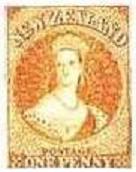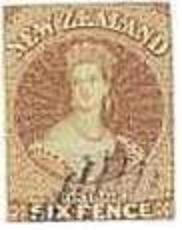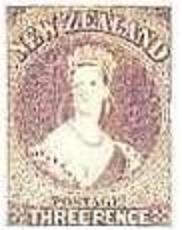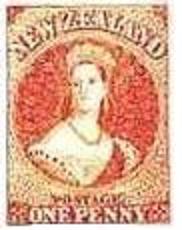
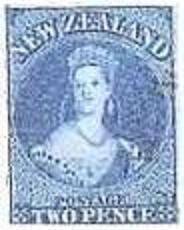
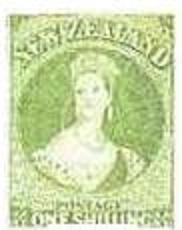
The three stamps above were the first NZ stamps issued. Known as the "Chalon Heads" because the design was taken from
a portrait of Queen Victoria done by Alfred Chalon, they are also referred to as the "Full Face Queens" to distinguish them from a later issue of stamps, showing Queen Victoria facing sideways, thus the "Sideface" series.
All the "Chalons" have the same layout, but with different colors and values obviously. The three shown above were the original issue, being printed in England in 1854, on paper with a large star watermark by Perkins, Bacon, London, so are sometimes referred to as the "London Prints." They are very scarce and quite valuable. They are also difficult to identify, for a non-expert.
The 1d stamp is a rich Carmine Red, the 2d is Blue with a greenish shade, the 1/- is a yellowish green. (12 pennies = one shilling. We use 1s instead of 1/-.) The 2d and the 1s watermarks appeared slightly blue, due to an interaction between the ink and the paper.
On completion of the printing run, the printed sheets, the printing press, the plates, a supply of paper, gum and ink were sent to NZ, where the stamps were first issued on the 18th July, 1855. Inscribed with 'Postage' these stamps were not perforated, but were cut from the sheet beforehand, or as needed. The sheets had 240 stamps, in 20 rows of 12 stamps.
50 sheets, being 12,000 stamps of the 1d red, 275 sheets, being 66,000 stamps of the 2d blue, and 33 and 1/3rd sheets, being 8,000 stamps of the 1s were delivered.
Further printings were made in NZ using the original plates, by J Richardson in Auckland. He used an unwatermarked blue paper from 1855 to 1857, printing 29,000 of the 1d stamp in Nov/Dec 1855, with shades that ranged from dull orange to orange vermillion. It is presumed the 1d "orange" at right, came from this printing.
More of the 2d were printed in 1856. Shades ranged from pale blue to deep shades of blue. The 1s was also reprinted in 1856, with shades listed as pale green to a greenish blue like that on the 2d. In 1858 the paper was changed to a white type. Most of it was thick and soft, but a harder thinner type was also used. Again, all with no watermarks.
The 6d brown stamp was issued on August 8th 1859, being printed by Richardson using a plate made in London by Perkins, Bacon. Shades included bistre brown, chestnut, and pale to deep brown.
In February 1862, John Davies was employed as Goverment Stamp Printer. As a Government employee, he was required to use the "Official" Star watermarked paper originally supplied from London. This led to some confusion, with his unperforated issues being mistaken for London prints, especially later when a carmine colour was used for the 1d stamp reprints. Around April 1862, stamp demand had increased greatly, and stocks of the London supplied star watermark paper were exhausted, so Davies used a very thin paper known as pelure, for all four values.
New stocks of watermarked paper and a 3d plate arrived in late 1862, with the 3d brown-lilac being issued on Jan 1st 1863. Some 120,000 copies were printed, lasting through until another printing in 1865. This printing, and other reprints, again depleted the watermarked paper, so the reprints of the 2d blue were done using a thick soft unwatermarked paper.
Some 'unofficial' perforations began turning up about this time. It is believed they were done in Dunedin, using a gauge 13 line machine.
An official perforating machine using 12 1/2 perfs was introduced in 1864, as was a NZ watermark which was used on 1d, 2d, 6d and 1s values. Some of the 1d and 1s stamps on NZ watermarked paper were perforated, some were not. The 2d blue on NZ watermark also has both perforated and unperforated varieties. The 2d plate was badly worn at that time.
Late in 1864, the printing office moved to the new Capital City of New Zealand, Wellington. From there, the 4d rose coloured stamp was issued in 1865, but the colour was quickly changed to yellow, as it was too close in colour to the 1d. In 1865 the printing plate for the 2d stamp, the most used, was so badly worn that a new plate was sent from London.
Be aware that some perforated stamps were trimmed down to try and pass them off as a more valuable unperforated variety. Check watermarks, paper type and colours.
For more info, look at the following sites.
100megsfree3.com
nzstamps.org.uk
If you have further information for these pages which might assist other users, please contact us. Your expertise will be most welcome. As will any corrections or suggestions.
Please use the browsers BACK button to return to your previous page,
or click here to return to the website main menu.






